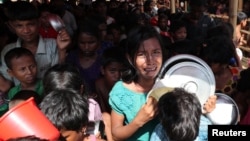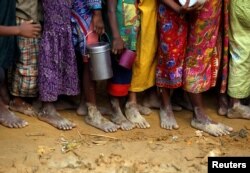Rohingya children in Myanmar and Bangladesh face a tenfold increase in malnutrition compared to last year and require immediate attention, the International Rescue Committee said in a statement Friday.
A recent survey conducted by humanitarian agencies led by International Rescue Committee (IRC) partner Action Against Hunger (ACF) in the Cox’s Bazar region of Bangladesh found that 40,000 Rohingya children between the ages of 6 months and 5 years require life-saving assistance and more than $12 million is needed to respond to such humanitarian crisis.
The survey revealed an acute malnutrition rate of 7.5 percent, nearly four times the international emergency level and 10 times higher than last year.
Children younger than 6 months face a tenfold increase in mortality based on the circumference of their arms, the statement said.
The IRC expects 200,000 new arrivals in coming weeks, bringing the total refugee population in Bangladesh to more than 1 million, exacerbating the crisis further.
“The conditions we are seeing in Cox’s Bazar create a perfect storm for a public health crisis on an unimaginable scale,” said Cat Mahony, the IRC’s emergency response director in Cox’s Bazar.
“Extremely vulnerable families with unmet health needs, high levels of food insecurity, limited access to health services and appalling conditions for hygiene, sanitation and access to clean drinking water — all of which contribute to these awfully high rates of malnutrition,” Mahony said.
The IRC has launched an emergency response on both sides of the Bangladesh-Myanmar border for displaced Rohingya, opening four specialized 24-hour care centers with ACF for the emergency treatment of severe acute malnutrition, as the first step.











